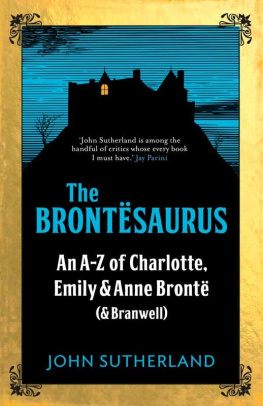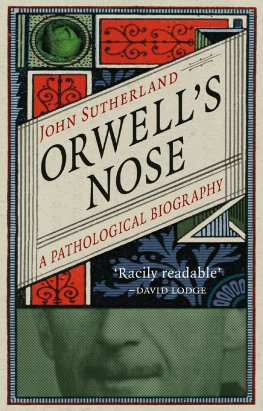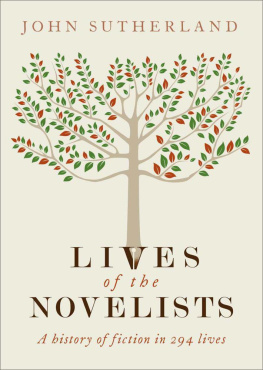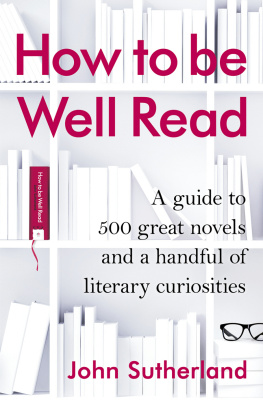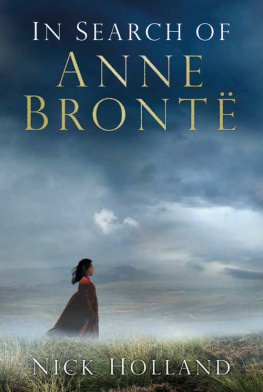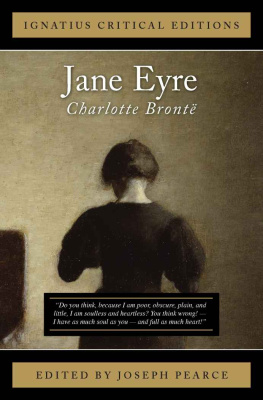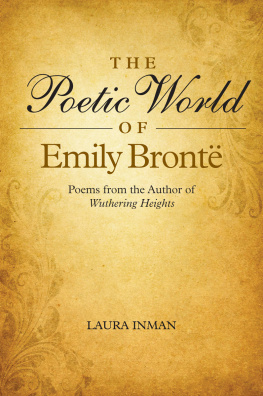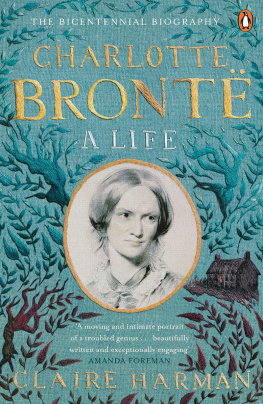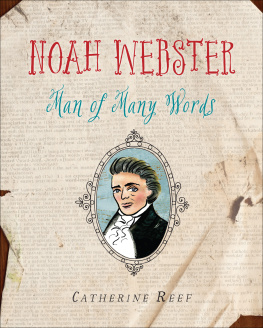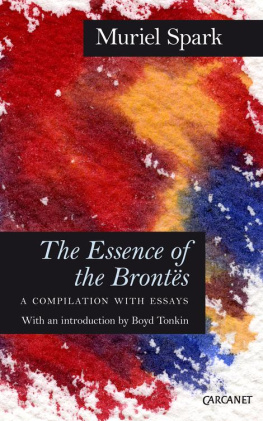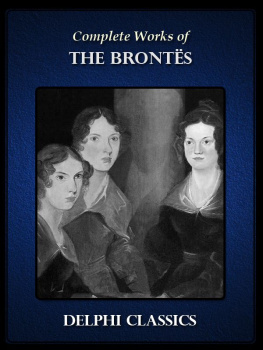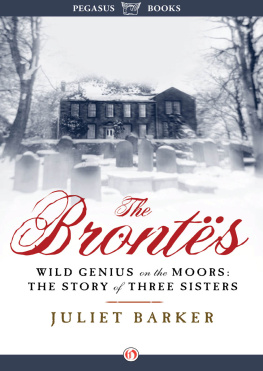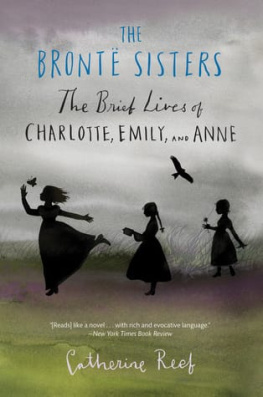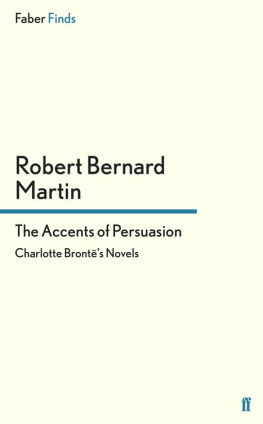The
BRONTSAURUS
The
BRONTSAURUS
An A-Z of Charlotte, Emily & Anne Bront
(& Branwell)
JOHN SUTHERLAND

Published in the UK in 2016
by Icon Books Ltd, Omnibus Business Centre,
3941 North Road, London N7 9DP
email:
www.iconbooks.com
Sold in the UK, Europe and Asia
by Faber & Faber Ltd, Bloomsbury House,
7477 Great Russell Street,
London WC1B 3DA or their agents
Distributed in the UK, Europe and Asia
by Grantham Book Services, Trent Road, Grantham NG31 7XQ
Distributed in the USA
by Publishers Group West,
1700 Fourth Street, Berkeley, CA 94710
Distributed in Australia and New Zealand
by Allen & Unwin Pty Ltd,
PO Box 8500, 83 Alexander Street,
Crows Nest, NSW 2065
Distributed in South Africa
by Jonathan Ball, Office B4, The District,
41 Sir Lowry Road, Woodstock 7925
Distributed in India by Penguin Books India,
7th Floor, Infinity Tower C, DLF Cyber City,
Gurgaon 122002, Haryana
Distributed in Canada by Publishers Group Canada,
76 Stafford Street, Unit 300,
Toronto, Ontario M6J 2S1
ISBN 978-178578-143-8
Text copyright 2016 Icon Books Ltd
Except Jane Eyre abbreviated: text copyright 2016 John Crace
No part of this book may be reproduced in any form, or by any means, without prior permission in writing from the publisher.
Typeset in Adobe Jenson Pro by Marie Doherty
Printed and bound in the UK by Clays Ltd, St Ives plc
ABOUT THE AUTHOR
John Sutherland is Lord Northcliffe Professor Emeritus at University College London and an eminent scholar in the field of Victorian fiction. He is the author of several books, including The Longman Companion to Victorian Fiction (Longman, 2009) and the bestselling popular titles Is Heathcliff a Murderer? (OUP, 1995) and Can Jane Eyre Be Happy? (OUP, 1996). His more recent works include Lives of the Novelists: A History of Fiction in 294 Lives (Profile, 2011) and A Little History of Literature (Yale, 2013).
PREFACE
Like most, I suspect, who read Wuthering Heights early in life, the novel has smouldered in my mind ever since rekindled by regular rereading. I remember taking the book out of the school library (an Everyman edition) aged fifteen. I entered my name in the borrowing ledger.
A day or two later, a senior boy came up to me. How did you like it? he asked. It was conspiratorial. He, like me, was someone who had discovered the novel. It was something to keep private, lest the teachers, who claimed they knew everything, got their pedagogic paws on it. It was secret treasure. I went on to read, over the following years, the poignantly short Brontan oeuvre.
In my formative years, the reputation of the Bronts had to contend with the lofty anathema proclaimed by F.R. Leavis in The Great Tradition a work of biblical authority in the postwar period. Leavis found no place for them in his selection of British novelists who really mattered. Charlottes three novels had only interest of a minor kind, he proclaimed. Wuthering Heights was granted to be astonishing, but a sport: a term used by geneticists to indicate life forms outside the main evolutionary line. A freak, or deviant phenomenon. It belonged not in the great tradition of English fiction but in the Ripleys Believe It or Not! museum of literature.
The most perceptive critics of the Bront oeuvre think differently, and more reverently, from Mrs Gaskell and Mrs Humphry Ward onward, to Daphne Du Maurier, Rebecca Fraser, Sally Shuttleworth, Margaret Smith, Lucasta Miller, Juliet Barker, Claire Harmon, Winifred Gerin, Sandra Gilbert and Susan Gerber, Gayatri Spivak, and (for me the most enlightening) Dorothy Van Ghent. Jean Rhys (with Wide Sargasso Sea) and Daphne Du Maurier (with Rebecca) went on to elaborate Brontan designs into second-generation Brontan fiction, as fine as Jane Eyre, the work they were paying homage to. This list could be enlarged.
This fancifully entitled book is homage to the Bronts (and their most perceptive critics) in an anniversary year. It reflects, I hope, a pleasure I have had over many decades reading them, ever since that first, treasured, reading of Wuthering Heights.
John Sutherland
ANNES LAST JOURNEY
The Haworth death toll it came as regularly as Christmas worked against the Bronts ever mustering as a complete family. They are, nonetheless, forever gathered in one place: under the pillar over their vault in the chapel of Haworth church.
There is, however, an absentee. Its surprising, given the fact that Anne was, ostensibly, the most obedient and homebound of the four children who made it into adulthood. Anne, the baby of the family, and asthmatic, was on grounds of physical fragility spared the ordeal of Cowan Bridge school, the institution where TB had claimed the lives of her two eldest sisters, Maria and Elizabeth. Gentle is one of the few defining epithets applied to Anne as a girl. In one of her brief spells of formal education, Anne won a good conduct medal an award which one strains to imagine decorating the juvenile breasts of Emily, Branwell or Charlotte.
But there was, her biographers argue persuasively, steel in her mix. Annes first employment, aged eighteen, was with the Ingham family at Blake Hall, near Mirfield. The Ingham children were spoilt and malicious and she was dismissed after a year for not indulging their nastiness. Its nice to think that the Inghams lived to read themselves portrayed as the odious Bloomfields, in Agnes Grey.
Gentle and dutiful as she may have been, Anne does not gild the governesss life with Jane Eyreish romanticism. She is more of Jane Fairfaxs party (in Jane Austens Emma) that governessing is the domestic English slave trade. Particularly stomach-turning is the depiction of young Tom Bloomfield torturing (fettling) birds. When Agnes remonstrates, she is blandly informed that she is a servant and should mind her own business by gum! They are lesser creation: so is she. Governesses, despite the name, govern nothing.
Anne went on to a more salubrious post with the Revd Edmund Robinson, and his wife Lydia (the destroyer of Branwell, see below, Branwells Robinsoniad, page 22) at Thorp Green Hall (immortalised as Horton Lodge in Agnes Grey), near York. Anne was with the Robinsons for five years. Her holidays at Haworth were short. The happy, late section of Agnes Grey draws on her time at Thorp Green, merging finally into the happy ever after of the heroines marriage to the ubiquitous curate in the Bront world: something that would never, alas, happen to the author herself. (It was her sister, Charlotte, who married the ever-present curate see below, Mr Charlotte Bront, page 95.)
Particularly wonderful for Anne were the Robinson familys long summer holidays in Scarborough. The seaside resort figures in both her novels (its near Linden-Car in The Tenant of Wildfell Hall). Her first publication, Lines Composed in a Wood on a Windy Day, is about being at Thorp Green, and dreaming about Scarborough:
I wish I could see how the ocean is lashing
The foam of its billows to whirlwinds of spray;
I wish I could see how its proud waves are dashing,
And hear the wild roar of their thunder today!
What Scarborough meant to her is expressed, ecstatically, in the penultimate chapter of Agnes Grey, rhapsodising about the sands:
And then, the unspeakable purity and freshness of the air! There was just enough heat to enhance the value of the breeze, and just enough wind to keep the whole sea in motion, to make the waves come bounding to the shore, foaming and sparkling, as if wild with glee. Nothing else was stirring no living creature was visible besides myself. My footsteps were the first to press the firm, unbroken sands; nothing before had trampled them since last nights flowing tide had obliterated the deepest marks of yesterday, and left it fair and even, except where the subsiding water had left behind it the traces of dimpled pools and little running streams.
Next page
